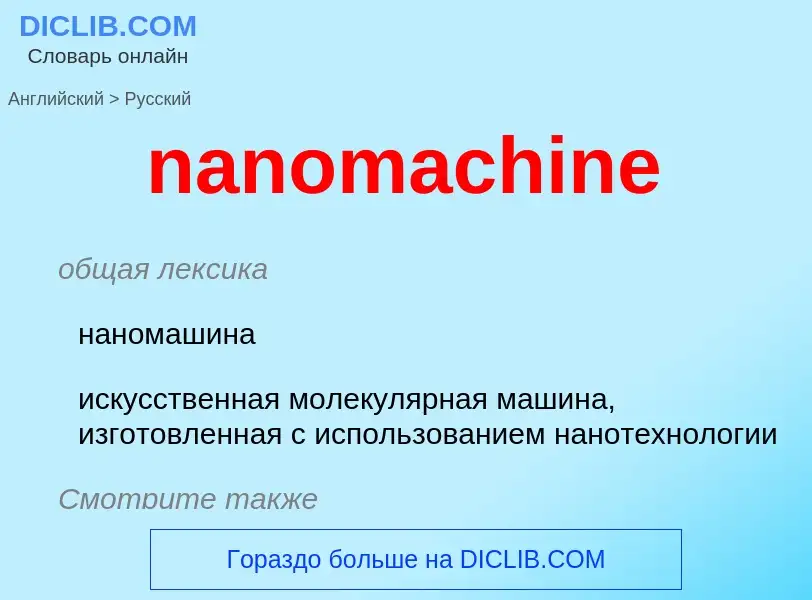Перевод и анализ слов искусственным интеллектом ChatGPT
На этой странице Вы можете получить подробный анализ слова или словосочетания, произведенный с помощью лучшей на сегодняшний день технологии искусственного интеллекта:
- как употребляется слово
- частота употребления
- используется оно чаще в устной или письменной речи
- варианты перевода слова
- примеры употребления (несколько фраз с переводом)
- этимология
nanomachine - перевод на русский
общая лексика
наномашина
искусственная молекулярная машина, изготовленная с использованием нанотехнологии
Смотрите также
Википедия

Molecular machines are a class of molecules typically described as an assembly of a discrete number of molecular components intended to produce mechanical movements in response to specific stimuli, mimicking macromolecular devices such as switches and motors. Naturally occurring or biological molecular machines such as kinesins and ribosomes (often in the form of multi-protein complexes) are responsible for vital living processes such as DNA replication and ATP synthesis. For the last several decades, scientists have attempted, with varying degrees of success, to miniaturize machines found in the macroscopic world. The first example of an artificial molecular machine (AMM) was reported in 1994, featuring a rotaxane with a ring and two different possible binding sites.
In 2016 the Nobel Prize in Chemistry was awarded to Jean-Pierre Sauvage, Sir J. Fraser Stoddart, and Bernard L. Feringa for the design and synthesis of molecular machines.
AMMs have diversified rapidly over the past few decades and their design principles, properties, and characterization methods have been outlined better. A major starting point for the design of AMMs is to exploit the existing modes of motion in molecules, such as rotation about single bonds or cis-trans isomerization. Different AMMs are produced by introducing various functionalities, such as the introduction of bistability to create switches. A broad range of AMMs has been designed, featuring different properties and applications; some of these include molecular motors, switches, and logic gates. A wide range of applications have been demonstrated for AMMs, including those integrated into polymeric, liquid crystal, and crystalline systems for varied functions (such as materials research, homogenous catalysis and surface chemistry).





![cis-trans]]'' isomerization. c) Translational motion of a ring (blue) between two possible binding sites (red) along the dumbbell-like rotaxane axis (purple). d) Rotation of interlocked rings (depicted as blue and red rectangles) in a catenane. cis-trans]]'' isomerization. c) Translational motion of a ring (blue) between two possible binding sites (red) along the dumbbell-like rotaxane axis (purple). d) Rotation of interlocked rings (depicted as blue and red rectangles) in a catenane.](https://commons.wikimedia.org/wiki/Special:FilePath/Molecular machine principle 1.png?width=200)

![oxidation]] or lowering of the [[pH]].<ref name=anelli/> oxidation]] or lowering of the [[pH]].<ref name=anelli/>](https://commons.wikimedia.org/wiki/Special:FilePath/Molecular shuttle first report.png?width=200)



